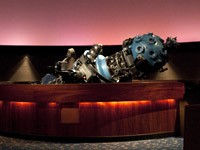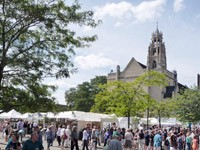[
{
"name": "500x250 Ad",
"insertPoint": "5",
"component": "15667920",
"parentWrapperClass": "",
"requiredCountToDisplay": "1"
}
]
Monroe County is about as diverse a community as you can find: a mid-size city, rural areas with orchards and farm markets, suburbs with 20th-century tract houses and shopping malls, and quaint, Victorian villages. The Genesee River and the Erie Canal bisect the county, more or less vertically and diagonally, so geology and history are a constant presence, shaping everything from traffic patterns to architecture and public festivals.
The county is literally a community of dozens of communities: 19 towns, nine villages, a combo town-village, and the City of Rochester (which has its own, numerous, defined neighborhoods). Given the number, there might be a good bit of similarity among all these, but each has its own distinct identity. Some draw it from their heritage, others from their location and their surroundings (parks, universities, manufacturing plants, farmland). And to many of the residents, the individuality of their particular hometown or neighborhood is a source of fierce pride. You can get a taste of the diversity by sampling half a dozen communities in the Community of Monroe, from rural Hamlin to downtown Rochester.
Hamlin
With attributes like Cowsucker Creek - so named for the alleged quicksand in the area - and a founder named Hannibal Hamlin, the Town of Hamlin is a movie set waiting to happen.
Geographically, this northeastern, outer-ring suburb is the second-largest town in Monroe County (behind Greece), with 44.4 square miles. The population as of the 2007 Census estimate was 9,002.
A big natural asset for Hamlin is its proximity to Lake Ontario. On a winter day, you can see Canada geese swimming near the shore on a serene, semi-frozen lake, surrounded by snowdrifts in various stages of their lifecycles. Breathtaking and perfect. During the summer, sailboats head off toward the horizon and children play along the shore.
Lake access is definitely a draw, says town historian Mary Smith. Many seasonal homes on the lake, especially along Shore Acres, are being razed and replaced with year-round dwellings many times the size, she says.
The aesthetic contribution of the lake is enhanced by Hamlin's long stretches of wide open spaces, orchards, and other hallmarks of its strong agricultural legacy.
The town attracts people looking for a more rural lifestyle and a slower pace of living, Smith says.
"There is a friendly atmosphere," she says. "I think the open spaces are a lure, unquestionably."
Some of the town's early residents came from an agricultural area of Germany, and they were prolific farmers. That background and a soil rich in nutrients gave Hamlin its agricultural identity, says Smith.
There are many German tombstones in Lakeside Cemetery on Moscow Road, and quite a few descendents of those early Hamlin residents still live in the town, Smith says.
In recent history, she says, Hamlin has been a town divided into almost equal thirds: east, central, and west. Each section has a separate school district and fire department. And residents tend to seek out separate shopping opportunities: those in the east head east toward Hilton, Smith says, those in the far west go to Holley and Albion, those in the center to Brockport.
"So in many respects, you have a division of loyalties," Smith says. "You don't have a single unifying element like you would if you had a central school district, for example."
Among the reminders of Hamlin's past: The North Star History Center on Walker Lake Ontario Road, a former one-room brick schoolhouse built in 1844. It later became a community center and is now the office of the town historian. The historian's collection and historical displays are there, too.
At one time, Hamlin had 15 one-room schoolhouses, Smith says. Some are gone, but most have been converted into homes. - BY CHRISTINE CARRIE FIEN
Henrietta
Without question, one of the most misunderstood and misrepresented communities in Monroe County is Henrietta.
The public perception is that the town is one big strip mall - and there is some truth behind that. Shopping plazas, big-box stores, office buildings, and chain restaurants dominate the Jefferson Road corridor, from Winton Road to the Rochester Institute of Technology. And the sprawling Marketplace Mall, at Jefferson Road and Hylan Drive, draws shoppers from across the region.
But consider this: only 12 percent of the town's land is used for commercial purposes, says Town Supervisor Mike Yudelson. Drive around the southern extremes of the town, down near its borders with Rush and Mendon, and farmland dominates the landscape.
Henrietta, as it turns out, is a diverse 'burb. Like many area communities, it first developed as an agricultural community. As a modern residential area, it's growing quickly. According to Census data, the population increased from 39,028 in 2000 to an estimated 45,240 in 2007. That's a larger increase than Webster, which had been Monroe County's growth leader for several years. In 2007, Henrietta surpassed Webster in the amount of building permits issued, too.
Henrietta is home to high-tech businesses like Delphi Corporation's research and development facility - one of two hydrogen fuel-cell operations in Monroe County. There are also manufacturers like CooperVision and Hammer Packaging. A Frito Lay warehouse here is powered, in part, by solar energy.
RIT is an important institution in the town and region, both in terms of higher education and employment. The college is also home to the National Technical Institute for the Deaf - the country's first and largest technical college for students who are deaf or hard of hearing.
Among Henrietta's churches is an ornate Buddhist temple, built by the Wat Lao Buddhadam. Each year, the Buddhist community holds festivals at the site on Martin Road.
But if the public insists on pigeonholing Henrietta as a strip-mall haven, town boosters can fire back with a powerful fact. Thanks in part to that concentrated commercial development, Henrietta boasts one of the lowest town tax rates in the county, $1.21 per $1000 assessed value. - BY JEREMY MOULE
Honeoye Falls
Honeoye Falls is frequently mentioned in the same breath as the General Motors fuel-cell facility located in the village. But there's some irony there: the plant is far less prominent than some the village's other features.
The impact of another power source, the currents of Honeoye Creek, have a more pronounced presence - and have had a more distinguishing effect. The village owes its existence to the mills that took advantage of that source.
Honeoye Falls was officially founded in 1838. But the first settler, Zebulon Norton, arrived in 1791, and shortly afterwards, he built a grain mill on Honeoye Creek. In subsequent years, more mills were built along the stream. And since the village was at the crossroads of two rail lines - which brought supplies to the mills - the milling industry thrived there long after it peaked in other places.
"It really was a bustling town," says village historian Lynne Menz.
Honeoye Falls - population 2,555 - is now one of the few villages in all of New York with two standing mills, Menz says. In other communities, mills were decimated by fires. The dust generated from milling was often set ablaze by the kerosene lamps that provided the light. Honeoye Falls' standing mills, which were built of brick, were able to resist such catastrophe.
The two remaining mill buildings serve other purposes now: Mendon Town Hall is located in one, and the other is a multi-use building containing a restaurant and art galleries.
Honeoye Falls, like other Victorian-era villages, has a collective sense of history. The preservation mindset has been institutionalized: downtown, particularly around the intersections of Main, Monroe, and Ontario streets, is a designated state historic district, and the village Planning Board gives closer scrutiny to changes proposed for those buildings.
Since its early days, the falls in the village center have been an attraction, and to this day, it's common to see a painter set up on the bridge overlooking the cascade, Menz says. Stone and brick buildings more than 100 years old house stores, businesses, and apartments, and Victorian homes and smaller 20th-century homes line the residential streets.
And two high-profile operations are thriving in the village. Custom Brewcrafters, known among other things for the beer it makes for local bars and restaurants, built its new brewery in the village. The General Motors fuel-cell facility, which is tucked into the village on Carriage Street, is getting more and more attention as the country starts to focus on fossil-fuel alternatives. It's where GM's Chevrolet Equinox fuel-cell vehicle, now in trial stages, was developed. - BY JEREMY MOULE
Charlotte
Situated at the mouth of the Genesee River, with Lake Ontario to the north, Charlotte still resembles a small village separate from the rest of the City of Rochester. "Charlottesburg," as it was first named by Colonel Robert Troup, is a working-class community that has survived many changes over the years.
Bordered by water on two sides, an area that was largely the hunting grounds of the Seneca Indians in the 1700's was transformed into one of the most important port towns on the Great Lakes, says Cynthia Howk, architectural research coordinator for the Landmark Society.
Charlotte became a hub for so much regional trade that many settlers at the time speculated that it, not Rochester, would one day become the major city in the area. Sailors who came to the Port of Genesee, says Howk, supported the area's first red-light district.
"We don't tend to think of Charlotte as a port community, but it was a very active one," says Howk. (And, she adds, the businesses in the red-light district were "among the many that did pretty well there at the time.")
Charlotte's relevance as a port diminished, but the area rebounded in the mid-1800's as one of New York's biggest summer resort communities, says Howk. Trolleys moved beachgoers back and forth from the city during the summer months.
Charlotte still relies heavily on its historical past. The site of the Port of Rochester, Charlotte has the distinct feel of a waterfront community, with leisure boats docked along the river. Ontario Beach Park, with its shaded picnic area, boardwalk, and wide sandy beach, draws thousands of beachgoers every year. The pier jutting into Lake Ontario is a popular place throughout the summer, particularly at sunset. Other attractions include the refurbished, historic lighthouse and the historic carousel, which is the last remnant of the original resort.
Charlotte has plenty of restaurants, and during the summer months outdoor concerts attract weekend crowds. And west of Ontario Beach Park are some of the city's most attractive homes: early and mid-20th-century houses along the lakefront, with architecture designed to take advantage of that unique location.
The Spirit of Ontario fast ferry traveled briefly between Toronto and Charlotte from 2004 to 2005. It was the last of at least four large ferries that have operated out of the port. - BY TIM LOUIS MACALUSO
The 19th Ward
Home to more than 20,000 residents, the 19th Ward in the southwest section of Rochester is one of the city's largest and oldest neighborhoods. Bordered by West Avenue, Genesee Street, Scottsville Road, and the Erie Canal, the area was originally called Castletown, and its settlement near the Genesee River pre-dates the city's. By the early 1900's, the 19th Ward had become a bustling community, with a trolley car servicing Thurston Road, plenty of shopping, and some of the city's most beautiful churches regularly drawing large congregations.
Although the neighborhood went through a period of decline, it has emerged as one of the city's most racially, ethnically, and economically diverse. This diversity, combined with the neighborhood's close proximity to the University of Rochester and Genesee Valley Park, has renewed interest in the 19th Ward.
"We have the most integrated neighborhood in the city," says long-time resident and city employee Bill Sullivan. "We've got university professors and Kodak executives living next door to families with lower incomes. And I know everybody says their neighborhood is friendly, but I really think the 19th Ward is the friendliest neighborhood in the city. That's something I don't think people expect when they come here."
Residents are organized, too. The 19th Ward has one of the oldest and most active neighborhood associations in the country. Founded in 1964, the 19th Ward Community Association has been engaged in nearly every major issue relevant to southwest Rochester - airport noise and runway expansion, housing, education, and crime prevention.
Sullivan attributes the 19th Ward's comeback to the neighborhood's abundant stock of spacious older homes, most of which were built between 1880 and 1930. The 19th Ward was not severely impacted by the city's zoning changes during the 1970's that allowed single-family homes to be converted into apartments, says Sullivan. About 70 percent of the homes remain single-family residences, many with long-time owner occupants.
"It really makes a big, big difference," says Sullivan. "We didn't get all of the landlords chopping these properties up into lots of apartments. We're very lucky that our neighborhood escaped most of that."
Though the 19th Ward is not registered as a historic neighborhood, Sullivan says several blocks qualify for the designation. First-time buyers, he says, are attracted to the large rooms, natural wood trim, wood floors, and other details typical of homes from this period.
Several recent developments - Brooks Landing, Corn Hill Landing, and the new Riverview apartment complex for UR graduate students on Plymouth Avenue - have increased foot traffic across the bridge from the River Campus into the 19th Ward. - BY TIM LOUIS MACALUSO
Grove Place
Anyone familiar with Rochester's Grove Place neighborhood knows what a unique treasure it is. Compact - covering only a few square blocks - and situated right on the edge of downtown's arts and entertainment district, Grove Place is one of the region's most charming, and most interesting, neighborhoods.
A combination of 19th-century houses, a historic townhouse, striking contemporary residences, tiny gardens, and the Eastman School of Music's dormitory, Grove Place is one of the city's earliest preservation districts. Historic buildings are protected by law, and the design of new structures has to be compatible with that of their older neighbors.
That it did not suffer from the decline of some urban neighborhoods is due solely to the vision and persistence of its residents, beginning in the1960's. They formed a strong neighborhood association that continues to this day. And they formed a corporation, Grovetown Inc., that bought and rehabilitated houses in the neighborhood and sold them, funneling the proceeds into additional neighborhood development.
Those efforts not only stabilized the area, but they also turned Grove Place into a sought-after neighborhood, where a condominium can sell for as much as $500,000. A major reason for its popularity: its location. Residents can walk to Geva Theater, the Strong Museum, and the Little Theatre; only a few blocks farther to the Memorial Art Gallery and the Rochester Museum and Science Center - and they can practically roll out of bed and into the Eastman Theatre.
Grove Place residents don't have to fight for a parking place to attend the Rochester International Jazz Festival, the High Falls Film Festival, and Image Out, Rochester's well-attended GLBT film festival. They take place at the edge of their neighborhood. Some of the region's finest, trendiest restaurants are right up the street or around the corner. And the YMCA's expansive Metrocenter anchors one corner of the neighborhood.
The demographics of Grove Place are probably no surprise: "Primarily empty nesters," says neighborhood leader Tom Fink. "Retired people, a number of single people, a lot of people who raised their families in the suburbs and wanted an urban environment" when their children left home. And there's a college-town flavor as well: about 800 Eastman School students live in the dorm and in apartments in the neighborhood. - BY MARY ANNA TOWLER
In This Guide...
Speaking of...
-

STUDENT SURVIVAL GUIDE '12: Off-campus fun
Aug 15, 2012 -

STUDENT SURVIVAL GUIDE '12: Special events calendar
Aug 15, 2012 -
SUMMER GUIDE '12: Thrills
Jun 6, 2012 - More »
Latest in Annual Manual
More by Jen Graney
-
ANNUAL MANUAL '08: Nightlife: Brewpubs
Mar 12, 2008 - More »





